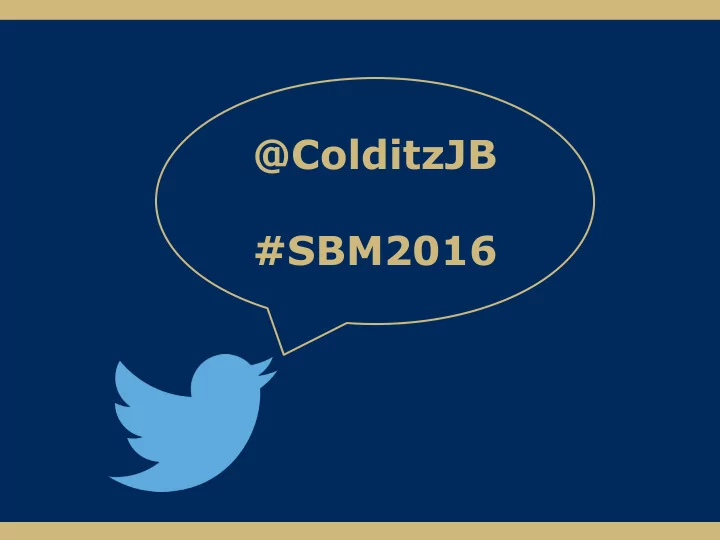

@ColditzJB #SBM2016
Use of Twitter to Assess Sentiment toward Waterpipe Tobacco Smoking Jason B. Colditz, MEd Maharsi Naidu, Class of 2018 Noah A. Smith, PhD Joel Welling, PhD Brian A. Primack, MD, PhD
Goals Summarize known harms related to waterpipe • tobacco smoking (WTS) List ways in which Twitter trends are currently • being used in public health and medicine Define “machine learning” and describe how it • can be used to automate large-scale data classification Compare Western and Eastern hemispheres • with regard to overall sentiment toward WTS
Background:WTS • Waterpipe Tobacco Smoking (WTS) – Hookah, Shisha, Narghile [nar ‧ ghee ‧ leh] Head / Bowl: • Flavored tobacco mixture • Charcoal to maintain heat Base: • Filled with water or flavored liquid • Smoke is cooled as it bubbles through Hose / Mouthpiece: • Shared by smokers • Typically not filtered
Background:WTS & Health Typical toxicants from tobacco combustion • – Additional toxicants from charcoal – Carbon monoxide and second-hand smoke – High volume of smoke Addictive potential • – From social to habitual use – Transitioning to other tobacco products
Background: WTS Epidemiology • Traditional and widely prevalent in Eastern global cultures – Widespread public health concerns of addiction and preventable disease • Novel and gaining popularity in Western global cultures – Fun social activity / cultural immersion – Seen as relatively harmless vs. “smoking”
Background:Twitter & Health • Twitter for “ Big Data” – Used by nearly a third of young adults – Access to large scale data via Twitter’s Application Programming Interface (API) • Twitter for Public Health infodemiology : – Natural disaster relief – Foodborne illness / Communicable diseases – E-cigarette sentiment & marketing
Background:Twitter Data • Characteristics – 140 characters includes text, links, and... • Hashtags: #SBM2016 #DataScience • Emoji: – Basic location metadata: Metadata Prevalence Accuracy Geo-location ~ 1% Calculated & exact Time Zone Common Self-reported & broad Location from Very Self-reported & aberrant user profile Common
Background: Machine Learning Machine Learning is a subfield of computer science that evolved from the study of pattern recognition and computational learning theory in artificial intelligence. • Computers are adept at discovering patterns in large sets of data. • Researchers can train computers to look for particularly useful patterns.
Methods: Data Collection • Twitter stream for 48 weekend hours: – From Friday, 11/14/2014, 17:00 GMT through Sunday, 11/16/2014, 16:59 GMT • Filters: – English language – Search terms: hookah, hooka, shisha, sheesha, narghile Tweets: N = 43,155
Methods: Human Coding • Random subset of 2,000 tweets – Independently double-coded • Coding: Relevant? No Yes • WTS Sentiment: False positive • Marijuana • Marketing • Pop-culture Positive? Negative?
Methods: Machine Learning • Supervised learning – Natural Language Toolkit (NLTK) for Python – Human coding as gold standard – Trained Naïve Bayes classifiers for WTS sentiment • Testing model’s Accuracy , Precision , and Recall • 3:1 training to testing ratio: Coded as WTS-relevant n = 1,345 – Unigram parameters • Individual words Sentiment classification: • Emoji Training Data Testing Data n = 1,008 (75%) n = 337 (25%)
Results: Human Coding • 655 (33%) Tweets excluded • Not WTS related • Marketing or pop-culture references • 1,345 Tweets considered relevant: • 54% Positive sentiment – Cohen’s K = 0.74 Neutral – Agreement = 87% Pos. • 21% Negative sentiment Neg. – Cohen’s K = 0.71 – Agreement = 92% • Disagreements manually adjudicated by coders to provide overall consensus
Results: Machine Learning • Positive sentiment : – Precision: 71% * & 76% † Recall: 84% * & 60% † – Overall accuracy: 73% • Exemplar predictive features: * Is positive: † Is not positive: 13.9 13.7 “starter” 7.6 12.9 “cigarettes” 5.9 “chill” 5.5 “hit” 4.8 4.9 “lounges” 3.4 3.5
Results: Machine Learning • Negative sentiment : – Precision: 41% * & 75% † Recall: 93% * & 60% † – Overall accuracy: 70% • Exemplar predictive features: * Is negative: † Is not negative: 23.1 “cigarettes” 6.7 “lads” 20.1 “shit” 6.4 “tonight” 18.6 “tar” 8.7 “ban” 6.9
Results: Hemispheres • Coded WTS tweets had time zone data 66% ( n = 890) • Western n = 727 • Eastern n = 163 • 56% positive* • 31% positive* • 24% negative • 23% negative * χ 2 =32.0, p < .001
Limitations / Considerations Twitter data biases • – English language – Timeframes Keyword search parameters • – Broad terms like “smoke” increase recall (sensitivity), but decrease precision (specificity) Classifier sophistication • – Unigrams vs. n -grams (bigrams, trigrams, etc.) Human coding is time and labor intensive • – Crowdsourcing (e.g., Mechanical Turk)
Discussion Waterpipe tobacco smoking (WTS) has serious • health risks and is gaining popularity in the US Twitter provides opportunities for researchers • and public health advocates to tap into online discourse and assess sentiment toward health behaviors Machine learning methods allow for • infodemiology: large-scale data categorization using geographic metadata, words, and symbols (e.g., emoji) Initial appraisal of our Twitter data indicated • proportionately higher positive sentiment toward WTS in the western hemisphere – This warrants further investigation
Thank You! Jason B. Colditz, M.Ed. jbc28@pitt.edu @ColditzJB ~ Center for Research on Media, Technology, and Health @CRMTH_Pitt
Recommend
More recommend